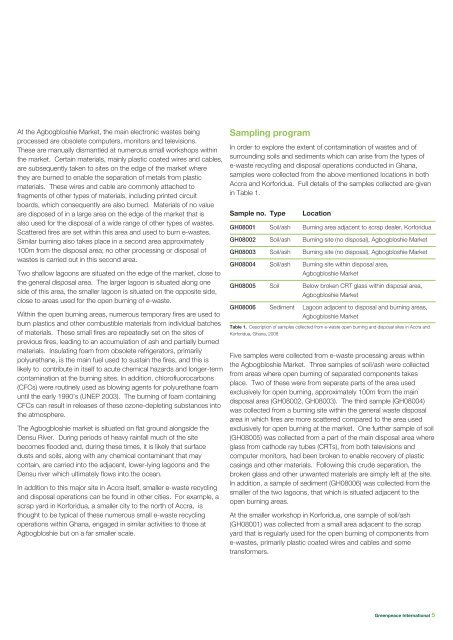Chemical contamination at e-waste recycling and ... - Greenpeace
Chemical contamination at e-waste recycling and ... - Greenpeace
Chemical contamination at e-waste recycling and ... - Greenpeace
Create successful ePaper yourself
Turn your PDF publications into a flip-book with our unique Google optimized e-Paper software.
©GREENPEACE / XXX<br />
At the Agbogbloshie Market, the main electronic <strong>waste</strong>s being<br />
processed are obsolete computers, monitors <strong>and</strong> televisions.<br />
These are manually dismantled <strong>at</strong> numerous small workshops within<br />
the market. Certain m<strong>at</strong>erials, mainly plastic co<strong>at</strong>ed wires <strong>and</strong> cables,<br />
are subsequently taken to sites on the edge of the market where<br />
they are burned to enable the separ<strong>at</strong>ion of metals from plastic<br />
m<strong>at</strong>erials. These wires <strong>and</strong> cable are commonly <strong>at</strong>tached to<br />
fragments of other types of m<strong>at</strong>erials, including printed circuit<br />
boards, which consequently are also burned. M<strong>at</strong>erials of no value<br />
are disposed of in a large area on the edge of the market th<strong>at</strong> is<br />
also used for the disposal of a wide range of other types of <strong>waste</strong>s.<br />
Sc<strong>at</strong>tered fires are set within this area <strong>and</strong> used to burn e-<strong>waste</strong>s.<br />
Similar burning also takes place in a second area approxim<strong>at</strong>ely<br />
100m from the disposal area; no other processing or disposal of<br />
<strong>waste</strong>s is carried out in this second area.<br />
Two shallow lagoons are situ<strong>at</strong>ed on the edge of the market, close to<br />
the general disposal area. The larger lagoon is situ<strong>at</strong>ed along one<br />
side of this area, the smaller lagoon is situ<strong>at</strong>ed on the opposite side,<br />
close to areas used for the open burning of e-<strong>waste</strong>.<br />
Within the open burning areas, numerous temporary fires are used to<br />
burn plastics <strong>and</strong> other combustible m<strong>at</strong>erials from individual b<strong>at</strong>ches<br />
of m<strong>at</strong>erials. These small fires are repe<strong>at</strong>edly set on the sites of<br />
previous fires, leading to an accumul<strong>at</strong>ion of ash <strong>and</strong> partially burned<br />
m<strong>at</strong>erials. Insul<strong>at</strong>ing foam from obsolete refriger<strong>at</strong>ors, primarily<br />
polyurethane, is the main fuel used to sustain the fires, <strong>and</strong> this is<br />
likely to contribute in itself to acute chemical hazards <strong>and</strong> longer-term<br />
<strong>contamin<strong>at</strong>ion</strong> <strong>at</strong> the burning sites. In addition, chlorofluorocarbons<br />
(CFCs) were routinely used as blowing agents for polyurethane foam<br />
until the early 1990’s (UNEP 2003). The burning of foam containing<br />
CFCs can result in releases of these ozone-depleting substances into<br />
the <strong>at</strong>mosphere.<br />
The Agbogbloshie market is situ<strong>at</strong>ed on fl<strong>at</strong> ground alongside the<br />
Densu River. During periods of heavy rainfall much of the site<br />
becomes flooded <strong>and</strong>, during these times, it is likely th<strong>at</strong> surface<br />
dusts <strong>and</strong> soils, along with any chemical contaminant th<strong>at</strong> may<br />
contain, are carried into the adjacent, lower-lying lagoons <strong>and</strong> the<br />
Densu river which ultim<strong>at</strong>ely flows into the ocean.<br />
In addition to this major site in Accra itself, smaller e-<strong>waste</strong> <strong>recycling</strong><br />
<strong>and</strong> disposal oper<strong>at</strong>ions can be found in other cities. For example, a<br />
scrap yard in Korforidua, a smaller city to the north of Accra, is<br />
thought to be typical of these numerous small e-<strong>waste</strong> <strong>recycling</strong><br />
oper<strong>at</strong>ions within Ghana, engaged in similar activities to those <strong>at</strong><br />
Agbogbloshie but on a far smaller scale.<br />
Sampling program<br />
In order to explore the extent of <strong>contamin<strong>at</strong>ion</strong> of <strong>waste</strong>s <strong>and</strong> of<br />
surrounding soils <strong>and</strong> sediments which can arise from the types of<br />
e-<strong>waste</strong> <strong>recycling</strong> <strong>and</strong> disposal oper<strong>at</strong>ions conducted in Ghana,<br />
samples were collected from the above mentioned loc<strong>at</strong>ions in both<br />
Accra <strong>and</strong> Korforidua. Full details of the samples collected are given<br />
in Table 1.<br />
Sample no. Type<br />
Loc<strong>at</strong>ion<br />
GH08001 Soil/ash Burning area adjacent to scrap dealer, Korforidua<br />
GH08002 Soil/ash Burning site (no disposal), Agbogbloshie Market<br />
GH08003 Soil/ash Burning site (no disposal), Agbogbloshie Market<br />
GH08004 Soil/ash Burning site within disposal area,<br />
Agbogbloshie Market<br />
GH08005 Soil Below broken CRT glass within disposal area,<br />
Agbogbloshie Market<br />
GH08006 Sediment Lagoon adjacent to disposal <strong>and</strong> burning areas,<br />
Agbogbloshie Market<br />
Table 1. Description of samples collected from e-<strong>waste</strong> open burning <strong>and</strong> disposal sites in Accra <strong>and</strong><br />
Korforidua, Ghana, 2008<br />
Five samples were collected from e-<strong>waste</strong> processing areas within<br />
the Agbogbloshie Market. Three samples of soil/ash were collected<br />
from areas where open burning of separ<strong>at</strong>ed components takes<br />
place. Two of these were from separ<strong>at</strong>e parts of the area used<br />
exclusively for open burning, approxim<strong>at</strong>ely 100m from the main<br />
disposal area (GH08002, GH08003). The third sample (GH08004)<br />
was collected from a burning site within the general <strong>waste</strong> disposal<br />
area in which fires are more sc<strong>at</strong>tered compared to the area used<br />
exclusively for open burning <strong>at</strong> the market. One further sample of soil<br />
(GH08005) was collected from a part of the main disposal area where<br />
glass from c<strong>at</strong>hode ray tubes (CRTs), from both televisions <strong>and</strong><br />
computer monitors, had been broken to enable recovery of plastic<br />
casings <strong>and</strong> other m<strong>at</strong>erials. Following this crude separ<strong>at</strong>ion, the<br />
broken glass <strong>and</strong> other unwanted m<strong>at</strong>erials are simply left <strong>at</strong> the site.<br />
In addition, a sample of sediment (GH08006) was collected from the<br />
smaller of the two lagoons, th<strong>at</strong> which is situ<strong>at</strong>ed adjacent to the<br />
open burning areas.<br />
At the smaller workshop in Korforidua, one sample of soil/ash<br />
(GH08001) was collected from a small area adjacent to the scrap<br />
yard th<strong>at</strong> is regularly used for the open burning of components from<br />
e-<strong>waste</strong>s, primarily plastic co<strong>at</strong>ed wires <strong>and</strong> cables <strong>and</strong> some<br />
transformers.<br />
<strong>Greenpeace</strong> Intern<strong>at</strong>ional 5

















